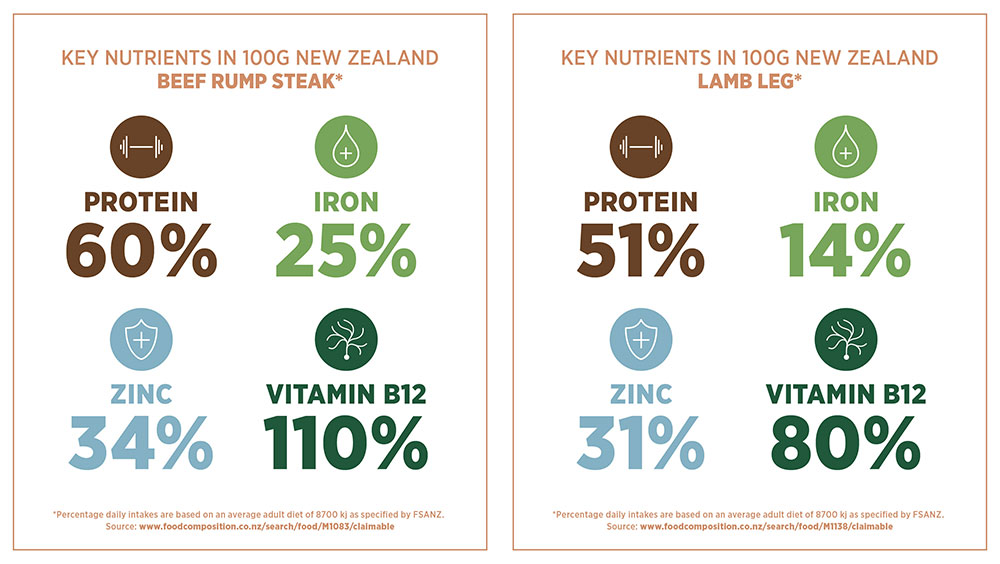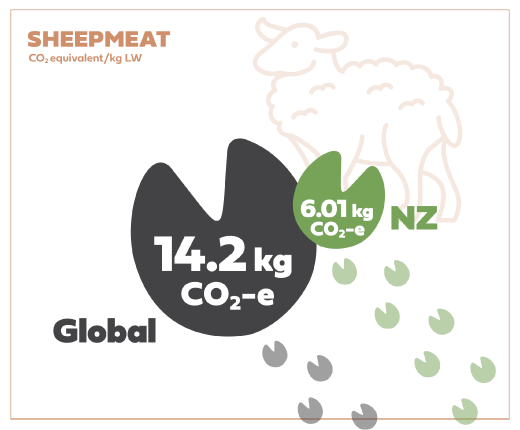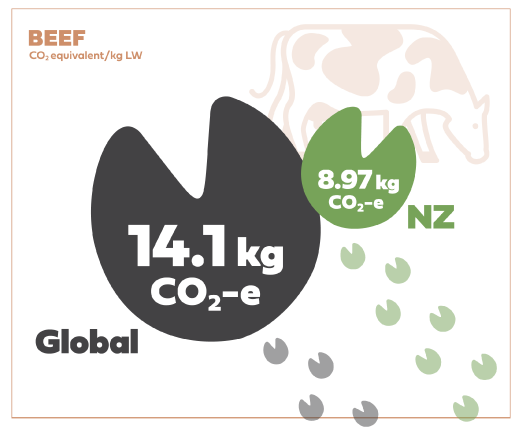As a result, New Zealand red meat stacks up very well on four key criteria:
Better for animals
In New Zealand, sheep and beef cattle are overwhelmingly free range and pasture fed, unlike the grain-fed/feed-lot livestock many people are concerned about. Our animals can roam outside all year round, thanks to our temperate climate.
view moreNew Zealand is among the lowest global users of antibiotics in cattle and sheep production – due to our extensive outdoor farming that reduces the chance of infections spreading, and strict regulations that only permit antibiotic use for animal health reasons (under veterinary control). New Zealand farmers do not use antibiotics to enhance production or yields. All antibiotic use is reported, and treated animals are withheld from market for specified periods.
(Source: Ministry of Health and Ministry for Primary Industries, 2017)view moreNew Zealand has very strict controls around the use of hormonal growth promotants, which can only be used under veterinary supervision with all relevant animals tagged on a government database. Since 2015 there has been no recorded use of hormonal growth promotants in red meat production.
(Source: B+LNZ)view moreOur animals live very naturally – animal welfare is a high priority for the sector and New Zealand has an excellent reputation for this globally. New Zealand has some of the strictest animal welfare standards in the world.
view more
Better for you
Lean red meat can be described as nature’s power pack – delivering a lot, in a little. Naturally low in sodium, it provides high quality protein with all essential amino acids along with bioavailable iron, zinc and B vitamins.
view moreKey nutrients in beef and lamb:

Eaten in moderation, red meat is an important part of a healthy diet. The New Zealand Ministry of Health Eating and Activity Guidelines recommends eating up to 350-500 grams of cooked red meat per week (equal to up to 750 grams raw), which aligns with the global recommendation of the World Cancer Research fund. This is around three meals per week lean red meat.
view moreOur nutrient requirements can also be higher at times of growth, development and repair, making nutrient-dense foods such as lean red meat an important part of your diet. Older people, infants and young children with smaller appetites but high nutrient requirements, can often fall short and so receive particular benefits from lean red meat.
view more
Better for the planet
Climate change
Greenhouse gas emissions from sheep and beef farming have decreased by 30 percent in absolute terms since 1990, while production levels have remained stable.
(Source: MfE, 2019)view moreThe New Zealand sheep and beef sector has a goal of net carbon neutrality by 2050 and is already a long way towards achieving this.
view moreNew Zealand is one of the most efficient producers in the world – the carbon footprint of sheep and beef production is estimated to be around half the global average (on-farm Life Cycle Analysis using the traditional calculation approach with a warming-impact gas comparison metric called GWP100). An emerging calculation approach shows New Zealand sheepmeat has not added any additional warming in the last 20 years and is arguably climate neutral (GWP* metric and also accounting for on-farm carbon-sequestering woody vegetation).
(Source: Mazzetto, Falconer, Ledgard, 2022)
view moreGlobal averages shown. The global range for sheepmeat is 6.8kg to 23.1kg. The global range for beef is 8kg to 31kg.


We’re making great progress towards being carbon neutral if you take into account the significant areas of carbon-sequestering woody vegetation on our sheep and beef farms, which is offsetting a substantial amount of our on-farm agricultural emissions.
view moreThis woody vegetation (made up of indigenous forest, mānuka/kānuka, exotic forest, indigenous shrubland and exotic scrub) covers around 2 million hectares, or just under 20 percent of all sheep and beef farmland area, and around 77 percent of it is indigenous.
Since 2003 the pastoral sector has invested around $80 million towards ways to reduce greenhouse gas emissions across the sector – including progress in selective breeding programmes in sheep which could reduce methane emissions by up to 1 percent per year. Other reductions have been made through improvements in factors such as feed and nutrition, and pasture management.
view more
Land
There is concern globally about the amount of land used for livestock production and deforestation as a result of increased livestock production (for example to grow crops for animal feed in feedlots). In New Zealand the trend has been in the opposite direction. The sheep and beef sector is using 4 million hectares less land than it was 30 years ago, with similar numbers of animals per hectare.
view moreAt most times of the year, New Zealand beef and sheep farmers follow a form of rotational grazing, believed to be one of the most sustainable forms of livestock production.
view moreThis process moves livestock around different sections of the pasture or between paddocks to prevent overgrazing and allow the land to renew, maintaining the health of the grass and soil while keeping carbon in the ground instead of being released into the air.
Many cropping farmers in New Zealand are also sheep and beef farmers. The two work symbiotically together. These cropping systems leave the land fallow for a period of time and rotate the livestock into these paddocks to rebuild the soil naturally through manure – and the use of stock helps control weeds and pests.
93 percent of land used for sheep and beef production in New Zealand is not suitable for growing food crops because it is rolling or steep hills.
view more(Source: Beef + Lamb New Zealand Economic Service, 2019)
Biodiversity
New Zealand’s indigenous biodiversity is unique and our farmers are kaitiaki (guardians) of the land. 24 percent of New Zealand’s total native vegetation (including woody native vegetation such as mānuka/kānuka and other native plants such as tussock) occurs on sheep and beef farmland - with land-use changes over the past 30 years adding 2 million hectares to the country’s conservation estate (the largest private sector contribution to biodiversity in New Zealand).
(Source: Pannell, Buckley, Case, Norton, 2021)
view moreOn average, approximately 25 percent of sheep and beef farms are covered by native vegetation. Much of this is regenerating and the sector is committed to continuing to build the biodiversity on our farms.
Water usage
As a result, our pasture-fed free-range sheep and beef farming uses significantly less extracted water such as irrigation than other forms of farming, such as plant-based production that often requires high levels of irrigation.
view moreGlobally, there’s a lot of attention on water use. With plenty of natural rainfall in New Zealand, the vast majority of water used in livestock production comes from the sky (‘green’ water, as opposed to being extracted from surface or ground water sources – or ‘blue’ water).
view more(Source: Zonderland-Thomassen et al)
These are both a fraction of the water footprint of grain-fed meat production globally.
Water quality
While there’s still work to do to improve freshwater health in some areas of New Zealand, including reducing nutrient losses to freshwater, New Zealand sheep and beef farms are doing their bit as they already have very low nitrogen leaching levels in comparison to other food producing systems. This is due to our generally low number of animals per hectare and low use of nitrogen fertiliser.
view moreAverage nitrogen leaching rates of New Zealand red meat farms are 14-17 kg per hectare – not much more than forestry (avg 6-9 kg/ha). On other farming systems, the average nitrogen leaching is closer to 30-40 kg per hectare depending on the land use and soils, and can go higher than 100 kg per hectare for some horticultural crops.
(Source: OverseerFM)The main impacts on water quality from sheep and beef production are sediment and E. coli. Measures of sediment and E. coli levels in waterways have been steadily improving over the last decade.
view moreSediment, from land erosion, has been reduced by planting trees on slip-prone land, or retiring it (taking it out of production). E. coli has been reduced by keeping cattle out of waterways through fencing and other measures. Improving water quality continues to be an ongoing focus for farmers and the industry.
The farmer-led catchment communities movement has been described as sweeping New Zealand. There are hundreds of groups working together to make real differences to water quality, biodiversity and more in their areas.
view more
Eco-efficiencies
Over the last 30 years, the sheep and beef sector has been producing more, with less. For example, New Zealand sheep numbers have reduced significantly (from 50 million, to 27 million) on 4 million hectares less land, while sustaining similar levels of production, through innovation and improvements in farm practice.
view moreWe are delivering greater value, with less overall impact.
Better for communities
Farming supports wider rural communities including schools, local businesses and community facilities, and creates a sense of identity in many regions of New Zealand.
view moreNew Zealand sheep and beef farms are overwhelmingly family owned (over 90 percent) with an average of five people living on each farm and many other operations are Māori Trusts.
(Source: Beef + Lamb New Zealand Economic Service)view moreOur sector accounts for nearly 5 percent of total employment in New Zealand – that’s over 92,000 people, on-farm and in processing and support services.
(Source: Heilbron, 2020)view moreThis represents nearly 5 percent of total employment in New Zealand.
Our sector plays an important role in growing the Māori economy and a significant proportion of the sector is Māori. It is estimated that nearly 40 percent of employees in processing plants are Māori and more than 15 percent of sheep and beef exports come from Māori farming interests.
(Source: Meat Industry Association / TeAra.govt.nz The Encyclopedia of New Zealand)view moreThe red meat sector generates $12 billion in income per year for New Zealand. It’s New Zealand’s second largest merchandise exporter and accounts for just over 16 percent of New Zealand’s total exports.
(Source: Heilbron, 2020)view moreThe export value of New Zealand red meat has increased dramatically since 1990 – with higher value ‘processed cuts’ rising from 53 percent to 98 percent of lamb exports – creating greater economic and employment benefits through New Zealand’s rural communities.
On average the sector contributes income of $3,300 per year to every household in New Zealand.
(Source: Heilbron, 2020)view more
Want more of the story?
Some key food concerns are more complex than an easy headline. So get the bigger picture – and the facts – from leading Kiwi experts.